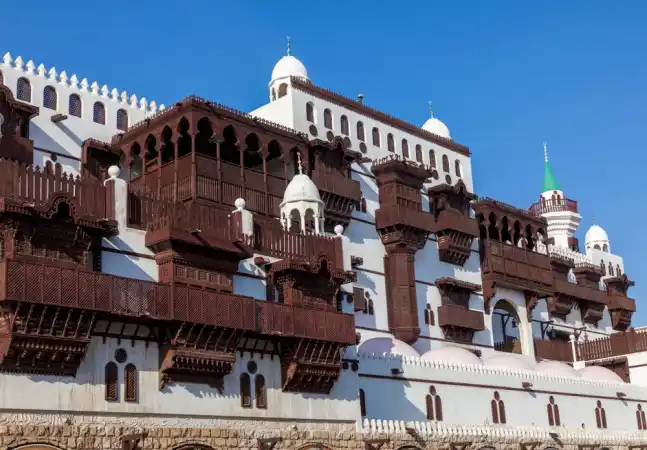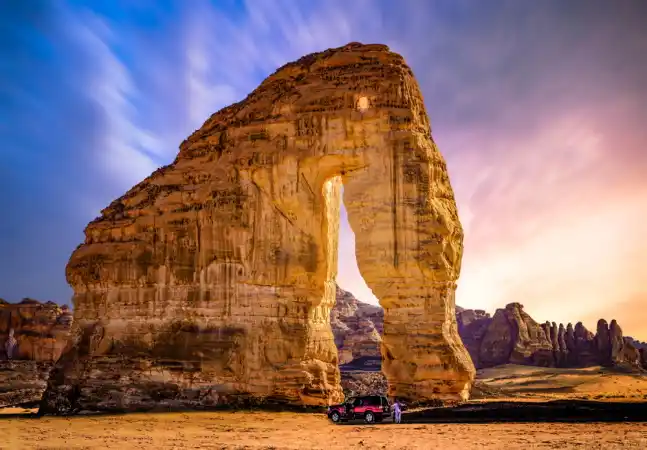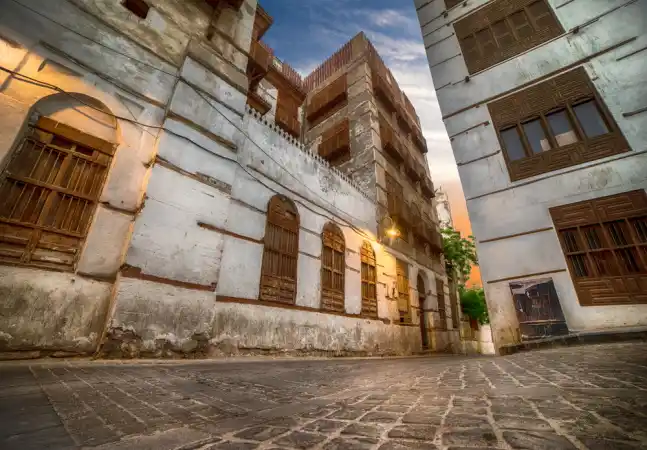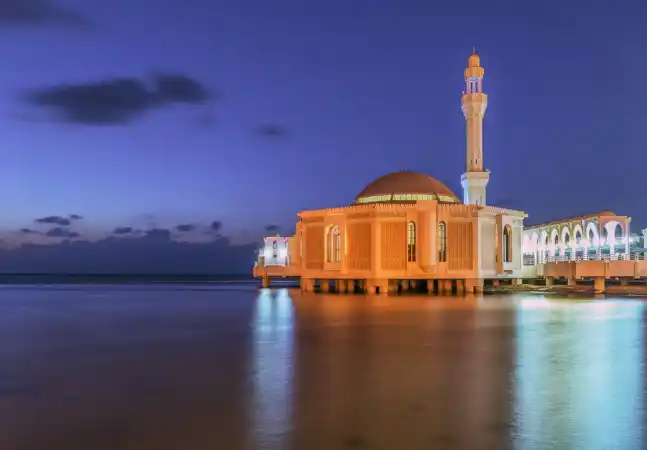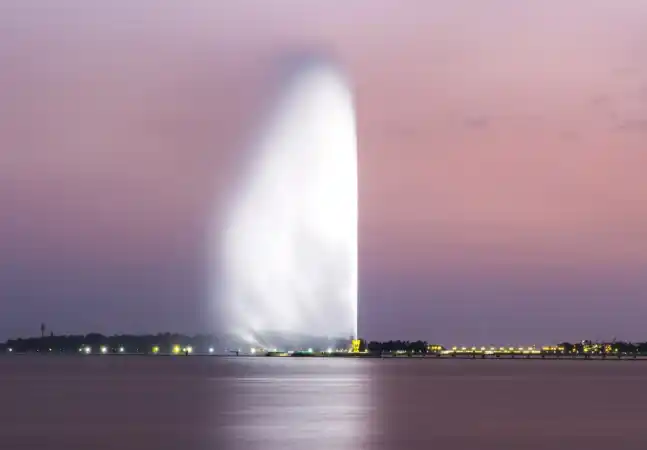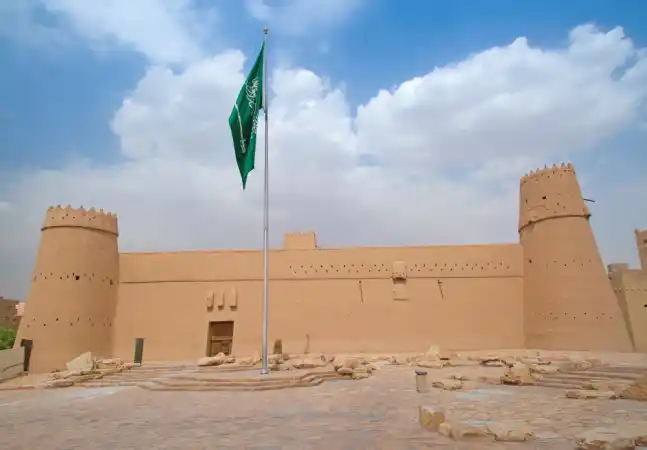The "Grand Tour of Saudi History" offers a sweeping journey through the rich and diverse historical tapestry of Saudi Arabia. This comprehensive tour takes you from the ancient rock carvings of Al-Ula to the bustling modernity of Riyadh, exploring pivotal sites that have shaped the Kingdom’s past and present. Discover the historic fortresses and traditional souks of Najran, delve into the cultural heritage of Jeddah’s Old City, and witness the grandeur of the Nabatean ruins at Madain Saleh. Each stop unveils a different chapter of Saudi Arabia’s storied history, providing a deep and immersive experience into the Kingdom’s cultural evolution, historical milestones, and architectural marvels.
Day 1: Riyadh
Arrive Riyadh and transfer to Four Points by Sheraton Hotel (4*). Overnight at the hotel.
Day 2: Riyadh
Morning visit historical city of Diriyyah, Musmak Fort and DiraSouq. Lunch at local restaurant. Afternoon visit National Museum followed by visit to Kingdom Tower Bridge for a panoramic view of Riyadh. Dinner and Overnight at the hotel.
The old city of Dirriyyah is located about 20km from the main city center of Riyadh. It is one of the most important archaeological sites from where the history of Saudi Dynasty begins. It is situated in the eastern part of the so-called Najd area in the valley known as Wadi Hanifa. The meaning of Najid is the high plateau, which forms the central part of Saudi Arabia.It is recorded by the chronicles that one of the person known as Ibn Dir, who was also the chief of al-Dir clan of Duru, which was belonging to Bani Hanifa tribe, was ruling this area. He had a vast fertile land in the valley, which he was not able to utilize completely due to lack of thin population of his clan. Therefore, he invited another clan of the same Banu Hanifa tribe to settle down on the fertile area of the Hanifa valley. Therefore, the clan named Murdah comes under the leadership of Mani Al-Muraydi in 1446 A.D in Wadi Hanifa. Ibn Dir gave land for the cultivation to the clan in the Wadi Hanifa and the clan settled down. They were the ancestors of the Al-Saud family who established their first rule at Dirriyya.
The Musmak Fort is one of the most important monuments in Saudi Arabia from where the modern Saudi History begins. It is an important historic landmark in the city of Riyadh. This palace was built during the reign of Abdullah bin Rashid in the year 1895 A.D. The reason for building this historic palace was to serve as military garrison for the Abdullah bin Rashid army who was operating under a Governor in Riyadh from the Hail. His Majesty King Abdulaziz on 15th January 1902 captured the fort.
Dira Souq is famous for its variety of old copper and brass objects including silver daggers, silver Beduins Jewelry and dresses. While entering from main access, one always smells sandal wood fragrance. DiraSouq is worth buying antique carpets and other useful Saudi heritage antiques.
The National Museum which opened in Riyadh in 1999 to celebrate the centenary of Saudi unification, was the result of an international design competition. The primary custodian of the Saudi national heritage and culture, the Museum is a place of learning and discovery, designed to sing out with quiet excitement and inspiration, to kindle pride in the Arab heritage and reverence for Islam. This national Landmark is composed of eight galleries telling the complete story of Arabian History from the creation of the universe to our modern era.
Day 3: Riyadh – Al Ula
Breakfast at the hotel. Transfer to the airport for your flight SV 1574 (0910-1055) to Al Ula. Arrive and transfer to tent village. Lunch at the local restaurant. Visit old houses. Dinner and overnight at Tent Village.
Day 4: Al Ula / Madain Saleh
Breakfast at the tent village. Today proceed for a full day excursion to magnificent Nabatean sites of Madain Saleh which includes QasrBint, Diwan, Qasr Farid etc. Lunch at local restaurant. Afternoon visit underground city, Lihyan etc. Dinner and overnight at tent village.
Wadi Al Ula, gateway to Madain Saleh is known for its Lion of the Lihyanites-predecessors of the Natateans (100 to 500 BC). Madain Saleh is the prime tourist attraction of the Kingdom. It was known as “Al Hijr” in the ancient times and served as a stopover on a very prosperous trade route. The cities lie on 9 square Km in an area of isolation about 845 Km from Jeddah in the northwestern part of Saudi Arabia between Tabouk and Madinah.
Qasr Bint means “Palace of Daughters”. This I the largest tomb at Madain Saleh sites. It is raised above ground level. An inscription plaque is indicated on the doorway. There are many archaeological inscription on the sand rocks which are considered by archaeologists to be Lihyanite script on top of the Athleb Mountain These inscriptions dateback to the 3rd–2nd century.
Day 5: Al Ula – Jeddah
Breakfast at tent village. Transfer to the airport for your flight SV 1631 (1215-1330) to Jeddah. Arrive Jeddah and transfer to Prime Al Hamra Hotel (4*) Lunch at the hotel. Afternoon proceed for visit to open Museum etc. Dinner and Overnight at the hotel.
Day 6: Jeddah
Breakfast at the hotel. Visit Hijaz Construction's old houses, Nasif House,Bughdadi House. Jamjom House, Noor Wali House, Matboli House, Almaemar Mosque, Old Gold Market in Bagel Street, Ain Farel Yuser, Shafei & Ukash Mosque. Lunch at local restaurant. Afternoon Visit Al Rahmah Mosque and Jeddah Aquarium. Visit Open Jeddah Museum and King Fahd Fountain. Dinner and overnight at the hotel.
Historical Houses were constructed from coral and reinforced with wood so that beams criss-cross the interior walls. Wooden balconies and casement windows are a special feature of Jeddah's style, with elaborate casements decorating the facades of the old houses - normally there is a small balcony fronting every window. Doors andwindows shutters are intricately carved. Some are painted and some remain simply wood with varnish.
The Nasif House was built during the 1850s by the well-known Nasif Family, one of the most influential trading families in thelong history of Jeddah. In the 19th and early 20th centuries thehouse was one of the most important building in Jeddah. It was here that King Abdul Aziz spent his first night in Jeddah, as the guest of Mohammed Nasif, after he lead his victorious armyinto the capital of the Western Province. The Municipality of Jeddahrecognized the architectural and historic value of the house and in1964 it was converted into a museum and put under Governmentcare.
The cornische of Jeddah is one of the most important archievementsof the city and is a major attraction for visitors to Jeddah. As Jeddah's Red Sea coast extends for more than 80 km, the Munici-pality has made use of this long expanse of waterfront and turnedit into place of fresh air for the city.
Day 7: Jeddah
Transfer to the airport for your departure flight.
